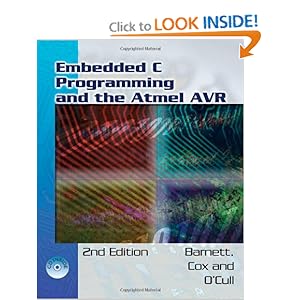LEARN AVR
Download learning book from direct link
some of contents
An embedded micro controller is a microcomputer that contains most of its peripherals
and required memory inside a single integrated circuit along with the CPU. It
is in actuality “a microcomputer on a chip.”
Embedded microcontrollers have been in use for more than three decades. The Intel
8051 series was one of the first microcontrollers to integrate the memory, I/O, arithmetic
logic unit (ALU), program ROM, as well as some other peripherals, all into
one very neat little package. These processors are still being designed into new products.
Other companies that followed Intel’s lead into the embedded microcontroller
arena were General Instruments, National Semiconductor, Motorola, Philips/
Signetics, Zilog, AMD, Hitachi, Toshiba, and Microchip, among others.
In recent years, Atmel has become a world leader in the development of FLASH
memory technology. FLASH technology is a non-volatile yet reprogrammable
memory often used in products such as digital cameras, portable audio devices, and
PC motherboards. This memory technology really pushed Atmel ahead in the microcontroller
industry by providing an in-system programmable solution. This, coupled
with the development of the AVR RISC (reduced instruction set computing)
core architecture, provides for very low-cost yet amazing solutions.
The next great step in this high-tech evolution was the implementation of high-level
language compilers that are targeted specifically for use with these new microprocessors.
The code generation and optimization of the compilers is quite impressive. The
C programming language, with its “make your own rules” structure, lends itself to
this application by its ability to be tailored to a particular target system, while still allowing
for code to be portable to other systems. The key benefit of a language like
this is that it creates pools of intellectual property that can be drawn from again and
again. This lowers development costs on an on-going basis by shortening the development
cycle with each subsequent design.
INTRODUCTION
xxii
One of the finest C language tools developed to date is CodeVisionAVR.Written by Pavel
Haiduc of HP InfoTech S.R.L., this completely integrated development environment (IDE)
allows editing, compiling, part programming, and debugging to be performed from one
PCWindows application.
The motivation that has led to the development of this book is the growing popularity of
the AVR and other RISC microcontrollers, the ever increasing level of integration (more on
a chip and fewer chips on a circuit board), and the need for “tuned thinking” when it comes
to developing products utilizing this type of technology. You may have experience writing C
for a PC, or assembler for a microcontroller. But when it comes to writing C for an embedded
microcontroller, the approach must be modified to get the desired final results: small,
efficient, reliable, reusable code. This text is designed to provide a good baseline for the beginner
as well as a helpful reference tool for those experienced in embedded microcontroller
design.
and required memory inside a single integrated circuit along with the CPU. It
is in actuality “a microcomputer on a chip.”
Embedded microcontrollers have been in use for more than three decades. The Intel
8051 series was one of the first microcontrollers to integrate the memory, I/O, arithmetic
logic unit (ALU), program ROM, as well as some other peripherals, all into
one very neat little package. These processors are still being designed into new products.
Other companies that followed Intel’s lead into the embedded microcontroller
arena were General Instruments, National Semiconductor, Motorola, Philips/
Signetics, Zilog, AMD, Hitachi, Toshiba, and Microchip, among others.
In recent years, Atmel has become a world leader in the development of FLASH
memory technology. FLASH technology is a non-volatile yet reprogrammable
memory often used in products such as digital cameras, portable audio devices, and
PC motherboards. This memory technology really pushed Atmel ahead in the microcontroller
industry by providing an in-system programmable solution. This, coupled
with the development of the AVR RISC (reduced instruction set computing)
core architecture, provides for very low-cost yet amazing solutions.
The next great step in this high-tech evolution was the implementation of high-level
language compilers that are targeted specifically for use with these new microprocessors.
The code generation and optimization of the compilers is quite impressive. The
C programming language, with its “make your own rules” structure, lends itself to
this application by its ability to be tailored to a particular target system, while still allowing
for code to be portable to other systems. The key benefit of a language like
this is that it creates pools of intellectual property that can be drawn from again and
again. This lowers development costs on an on-going basis by shortening the development
cycle with each subsequent design.
INTRODUCTION
xxii
One of the finest C language tools developed to date is CodeVisionAVR.Written by Pavel
Haiduc of HP InfoTech S.R.L., this completely integrated development environment (IDE)
allows editing, compiling, part programming, and debugging to be performed from one
PCWindows application.
The motivation that has led to the development of this book is the growing popularity of
the AVR and other RISC microcontrollers, the ever increasing level of integration (more on
a chip and fewer chips on a circuit board), and the need for “tuned thinking” when it comes
to developing products utilizing this type of technology. You may have experience writing C
for a PC, or assembler for a microcontroller. But when it comes to writing C for an embedded
microcontroller, the approach must be modified to get the desired final results: small,
efficient, reliable, reusable code. This text is designed to provide a good baseline for the beginner
as well as a helpful reference tool for those experienced in embedded microcontroller
design.

No comments:
Post a Comment